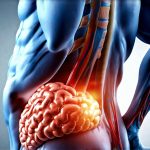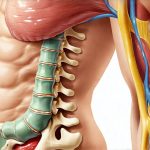Indigestion, a common ailment affecting millions, is often quickly attributed to dietary choices or stress. While these factors undeniably play a role, there’s a growing awareness amongst healthcare professionals – and increasingly among those suffering from chronic digestive issues – that the root cause can be surprisingly far removed from what we consume. It lies in how we hold ourselves: our posture. For many, the connection between slumped shoulders and stomach upset feels counterintuitive, yet the intricate relationship between musculoskeletal alignment and gastrointestinal function is becoming increasingly well understood. Ignoring this link can lead to a cycle of discomfort, misdiagnosis, and ineffective treatments.
Our bodies are not segmented systems operating in isolation; they’re interconnected networks where everything influences everything else. Poor posture doesn’t just affect our backs and necks – it impacts the space available for internal organs, constricts vital pathways, and even alters breathing patterns. These seemingly small changes can have a profound effect on digestive processes, leading to symptoms like bloating, heartburn, constipation, and general discomfort after eating. Understanding this interplay is crucial for taking proactive steps towards improved gut health and overall wellbeing. You might be surprised by the link between silent reflux and other symptoms.
The Mechanics of Digestion & Posture
Digestion isn’t simply about breaking down food; it’s a complex process involving mechanical action (chewing and churning), chemical breakdown (enzymes), and peristalsis – the wave-like muscle contractions that move food along the digestive tract. Optimal function requires adequate space for organs to operate efficiently, unobstructed pathways for nerves controlling digestion, and proper diaphragmatic breathing to stimulate gut motility. Poor posture directly compromises all three of these elements. A slumped position compresses the abdominal cavity, squeezing internal organs and hindering their natural movement. This compression can affect:
- The stomach’s ability to expand and contract properly
- The intestines’ peristaltic movements, leading to constipation or slow digestion
- Blood flow to the digestive system, reducing nutrient absorption
Furthermore, a forward-leaning posture often leads to shallow breathing from the chest rather than deep, diaphragmatic breaths. The diaphragm plays a vital role in massaging the abdominal organs during inhalation and exhalation, aiding digestion. Restricted diaphragmatic movement due to poor posture significantly reduces this internal massage, further contributing to digestive sluggishness. Imagine trying to efficiently mix ingredients in a bowl when you’ve only got limited space and can barely move your mixing arm – that’s essentially what happens within the digestive system when constricted by bad posture. The connection between sleep quality and digestion is also important to consider.
This isn’t just theoretical; studies have shown correlations between postural imbalances and gastrointestinal symptoms. For example, research has indicated that individuals with forward head posture are more likely to experience acid reflux and heartburn. The link is often explained by the increased pressure on the diaphragm and abdominal contents caused by the altered alignment. Essentially, when we slouch, we create a physical environment less conducive to healthy digestion. It’s also worth considering gut inflammation as a potential underlying factor.
How Posture Impacts Specific Digestive Issues
Different postural habits can exacerbate different digestive problems. For instance, prolonged sitting with rounded shoulders and a forward head is commonly associated with heartburn and acid reflux. This posture increases pressure on the esophagus, making it easier for stomach acid to flow back upwards. Conversely, a chronically hunched lower back can contribute to constipation by compressing the intestines and hindering their ability to effectively move waste through the digestive tract. It’s also important to consider that stress often manifests physically as postural changes – tension in the shoulders, a clenched jaw, or a rounded spine – which further exacerbate digestive issues.
The impact extends beyond common complaints like heartburn and constipation. Individuals with Irritable Bowel Syndrome (IBS) may find their symptoms significantly worsened by poor posture. The compression of the abdominal cavity can increase visceral sensitivity – meaning the gut becomes more reactive to stimuli – leading to increased pain, bloating, and altered bowel habits. Similarly, those with functional dyspepsia (chronic indigestion without an identifiable cause) might benefit from postural correction as it addresses a often-overlooked contributing factor. A holistic approach that considers both dietary adjustments and postural alignment is frequently more effective in managing chronic digestive disorders than focusing solely on diet alone. Many people don’t realize the link between menstrual cycles and gut health, too.
Recognizing Postural Imbalances
Identifying your own postural habits is the first step towards improvement. It’s surprisingly difficult to self-assess accurately, as we become accustomed to our habitual positions. Here are some key indicators of common imbalances:
- Forward Head Posture: Ears positioned forward beyond the vertical line of the shoulder. This often leads to neck pain and can contribute to acid reflux.
- Rounded Shoulders: Shoulders slumped forward, creating a curvature in the upper back. This compresses the chest cavity and restricts breathing.
- Hunched Back (Kyphosis): An exaggerated rounding of the upper spine. This can put strain on the lower back and impede digestion.
- Pelvic Tilt: Either an anterior (forward) or posterior (backward) tilt of the pelvis, impacting spinal alignment and abdominal pressure.
Regularly checking your posture in a mirror, or even asking a friend to observe you while standing and sitting, can provide valuable insights. There are also apps and devices available that use sensors to track your posture throughout the day and offer gentle reminders to adjust. Remember, awareness is key. It’s important to consider intestinal gas as a symptom too.
Simple Postural Corrections
Fortunately, improving posture doesn’t require drastic changes or expensive equipment. Small, consistent adjustments can make a significant difference. Here are some practical steps you can take:
- Ergonomic Workspace: Ensure your workstation is set up correctly – monitor at eye level, chair provides adequate back support, and feet flat on the floor.
- Regular Movement Breaks: Get up and move around every 30-60 minutes to counteract prolonged sitting. Simple stretches can help release tension in the shoulders and back.
- Strengthening Exercises: Focus on strengthening core muscles (abdominal and back) as they provide support for the spine. Pilates and yoga are excellent options.
- Diaphragmatic Breathing Exercises: Practice deep, belly breathing to activate the diaphragm and promote gut motility.
A simple exercise is to imagine a string pulling you up from the crown of your head, gently lengthening your spine without straining. Avoid locking your knees or excessively arching your back. Consistency is more important than intensity; even 5-10 minutes of focused postural work each day can yield noticeable results. Poor posture and digestive flow are also closely connected.
Seeking Professional Guidance
While self-correction can be effective for mild imbalances, seeking professional guidance is recommended for persistent problems or if you experience pain. A physiotherapist or chiropractor can assess your posture comprehensively and develop a personalized treatment plan tailored to your specific needs. They may utilize techniques such as manual therapy, exercise prescription, and postural re-education to restore proper alignment. Additionally, consider consulting with a healthcare professional specializing in functional medicine or integrative health who understands the interconnectedness of posture, digestion, and overall wellbeing. This holistic approach ensures that all contributing factors are addressed for optimal results. Remember, addressing poor posture isn’t just about aesthetics; it’s about investing in your long-term digestive health and quality of life.


















